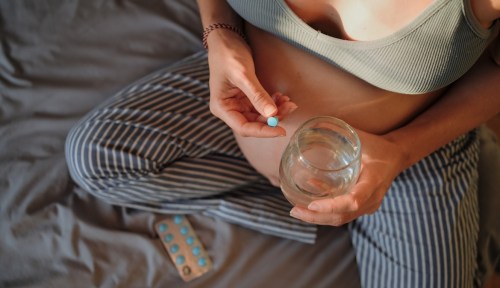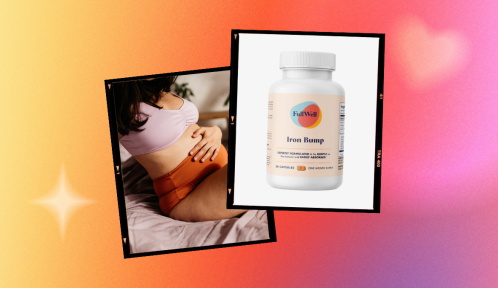Sarah Villafranco, MD, has a serious passion for plants—so much so that she left a career in emergency medicine to found natural beauty brand Osmia Organics in 2012. Here, the mom of two shares what she’s learned about keeping skin healthy and gorgeous through pregnancy—and beyond.
Being pregnant is a precious, terrifying, and thrilling time, when your hormones are vacillating like a metronome and everyone you know is doling out unsolicited advice. Between the “wisdom” being passed down from aunts you’ve never met to all the pregnancy information on the interwebs, you could work yourself into a frothing, worried frenzy before the pee dries on the stick.
So, take a breath and start with this reminder: Pregnancy is a time for celebration, and for finding as many ways to nurture yourself and that sweet peanut as you possibly can—and skin care is a huge part of that.
The simple truth is that there is no standardized set of guidelines. So I’ve used my doctor brain to do the homework and create some rules.
Of course, you want to keep yourself and your baby safe. You’re prepared to do your homework and exercise caution with sushi and unpasteurized cheeses, as you should. You’ll wear sensible shoes and drink extra water as it gets warmer. But when it comes to skin-care products, you may be left scratching your head, wondering how on earth to decide what’s safe and what isn’t.
The simple truth is that there’s no standardized set of guidelines. So I’ve analyzed the (few) available studies and the most reliable sources of information on the topic—and used my doctor brain to do the homework and create some rules.
Keep reading for my guide to natural skin care, to keep you radiant and healthy throughout your pregnancy.
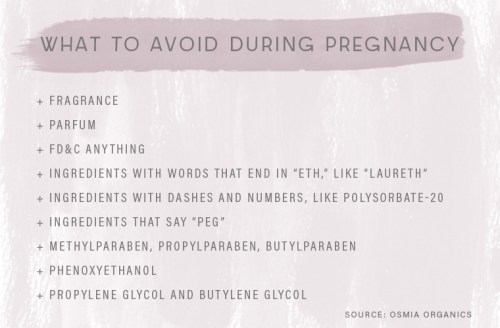
What to avoid: endocrine disruptors
Endocrine disruptors are ingredients that interfere with the normal function of our endocrine glands, which include the ovaries, testes, thyroid, parathyroid, thymus, adrenals, pineal, pituitary, hypothalamus, and pancreas.
Skin-care ingredients proving disruptive to these glands include parabens, phthalates, BPA, triclosan, and nonylphenol. Beauty companies use these chemicals for various reasons: preservation (parabens), fragrance (phthalates), packaging (BPA), surfactants (nonylphenol ethoxylates), and antibacterial effects (triclosan).
To be fair, these weren’t always known to be toxic, and serve worthy purposes—everyone wants a bacteria-free product that smells good! But times are changing, and we need to evolve with the science. These ingredients should be avoided in personal-care products—in pregnancy, and always. (And if you’re looking for a cheat sheet to help you decipher the skin-care aisle, here’s how to be a better reader of beauty labels.)
Specifically, there’s mounting confirmation that these EDCs (endocrine-disrupting chemicals), absorbed through the skin, accumulate in human blood and tissues over time and have hormone-disrupting effects. Some (like parabens) have been shown to decrease birth weight and gestational age at birth, and to shorten menstrual cycles in non-pregnant women. Others (think phthalates) have been linked to thyroid dysfunction, endometriosis, and possibly autism.
These are compelling reasons to switch to natural skin-care products during your pregnancy—and beyond. (And you should tell your fella to stop using synthetic fragrance, too—phthalates may decrease sperm count and quality!)

What to avoid: skin irritants
This category comes down to three words: sodium lauryl sulfate. As someone who has suffered with and become an expert in facial dermatitis, I can tell you this pesky chemical causes more trouble than you can imagine—and it’s in everything that foams.
It’s found in laundry detergent (even natural brands!), toothpaste (even natural brands!), shampoo (even…okay, got the idea?), face wash, and body wash. It can cause, contribute to, or exacerbate dermatitis (all forms), eczema, and psoriasis. Sometimes you’ll see sodium laureth sulfate, a gentler form of this surfactant, but don’t be fooled: Not only does it cause dermatitis, it has also been ethoxylated (which isn’t a good thing).
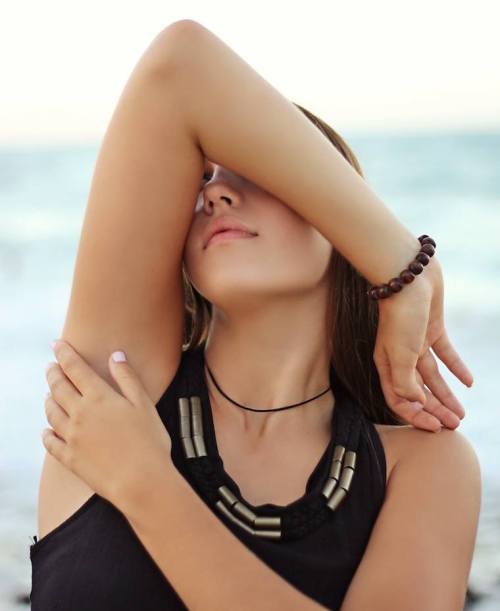
What to avoid: sneaky toxins
When I think of toxic things that could sneak into the skin-care routine of even an educated consumer, I think of the word ethoxylation. It’s a hard concept to explain without substantial risk of making your eyes glaze over, but ethoxylation involves being treated with ethylene oxide, a gnarly carcinogen.
The reaction creates a by-product called 1,4-dioxane, which is a likely contaminant in any ethoxylated ingredient. 1,4-dioxane is not only a potential carcinogen for you and your family, it’s also an environmental toxin that’s bio-accumulative—meaning that levels in soil, water sources, and organic matter are on the rise. More research is required, but it may be on par with microplastics and nanoparticles, both of which have potential to do measurable harm to the environment.
By using ethoxylated ingredients, you’re not only putting yourself at risk, you’re impacting the environment every time those ingredients wash down your drain. The easiest way to avoid them is to avoid ingredients that end in “eth” (sodium laureth sulfate), have dashes and numbers (polysorbate-20), or have the letters PEG in the name. Also, look for an ingredient called Emulsifying Wax NF—there are even some companies using it that probably don’t know it’s ethoxylated!
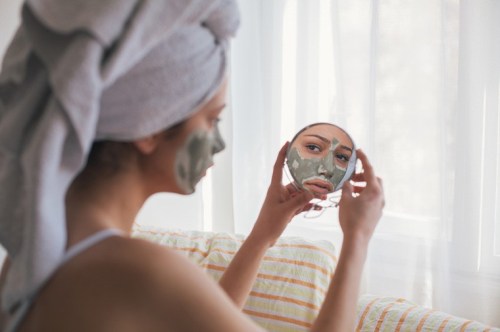
What to avoid: synthetic colors and petrochemicals
Synthetic colors and petrochemicals are two categories I recommend avoiding, but the evidence isn’t as strong. FD&C colors (those approved for use in cosmetics by the Food, Drug & Cosmetic Act) are under investigation for links to behavioral disturbances and allergy syndromes, but hard data remains to be established. (The evolving evidence is concerning, though.)
Regarding petrochemicals, there’s sufficient evidence to support avoiding the aggro ones like polycyclic aromatic hydrocarbons (think gasoline, coal, tar) during pregnancy, but no evidence that a little petroleum jelly or mineral oil will harm a developing fetus. This choice may involve more ethical and lifestyle considerations than toxicological ones.

What to use
Beautiful, natural skin care, of course! Stick to a less-is-more philosophy. Your body is experiencing huge, internal chemical shifts during pregnancy—not a great time to change up your skin-care routine frequently.
If you’re looking for a quick, effective way to decrease the number of chemicals you’re being exposed to, start with the products that cover the largest surface area. And definitely switch from body wash to an organic bar of soap, and from body lotion to body oil on wet skin.

Plus: Here are a few pregnancy-specific skin concerns that come up frequently
What you need to know about: stretch marksAsk your mom if she has them. That’s all that matters. You can apply shea butter to your belly to keep the skin supple and relieve itching, but if your mom had stretch marks, you may get them, too. Genetics win.
What you need to know about: melasmaThis is hyperpigmentation that can occur in lighter-skinned women during and after pregnancy, and is exacerbated by sun exposure. It often looks like darker patches on the upper lip, cheeks, or the forehead near the hairline. Huge, dorky hats and sunscreen are your best friends in managing melasma. For sunscreen, look for a mineral-based, unscented sunblock with no parabens, and apply daily. After you deliver, if you still have melasma, you can work with your dermatologist for solutions, which might involve a laser treatment down the road.
What you need to know about: acneIt’s so unfair: You’re moody, you feel fat, and you get zits? Because you don’t have the option of resorting to big guns like Retin-A, antibiotics, benzoyl peroxide, or salicylic acid, you really have to focus on cleaning up your diet, stress management, and not touching your face!
What you need to know about: things that itchYou may feel the urge to scratch, for lots of reasons. The simplest is just dry skin, easily remedied by a balanced diet (don’t skip the healthy fats), water consumption, and taking care of your skin with gentle dry-brushing and natural products. Persistent itching of the palms and soles could indicate liver issues, so you should see your doctor.
Hives or itchy bumps all over could indicate something called PUPPP (pruritic urticarial papules and plaques of pregnancy)—not scary, despite the title, but super annoying. For all itchy skin conditions, hot water will exacerbate things, so stick to lukewarm showers and baths until it resolves.
Lastly, remember that your mom probably did some stuff way more scary than anything I’ve mentioned here while she was pregnant with you, and you turned out just fine! Use these rules as a guide, do all things in moderation, and focus on the miracle in your belly—it’s the coolest thing a human body can do.
Welcome to the Well+Good Healthy Pregnancy Guide, a week-long series on how SoulCycle-loving, leggings-wearing, kale salad-obsessed women can bring wellness into the next nine months (and beyond).
Speaking of Mom, don’t forget to thank her for her awesomeness this weekend—and get her a great Mother’s Day gift! And enjoy a bit of wisdom from our mamas—here are the best wellness lessons that were passed down to Team W+G.
Sign Up for Our Daily Newsletter
Get all the latest in wellness, trends, food, fitness, beauty, and more delivered right to your inbox.
Got it, you've been added to our email list.

